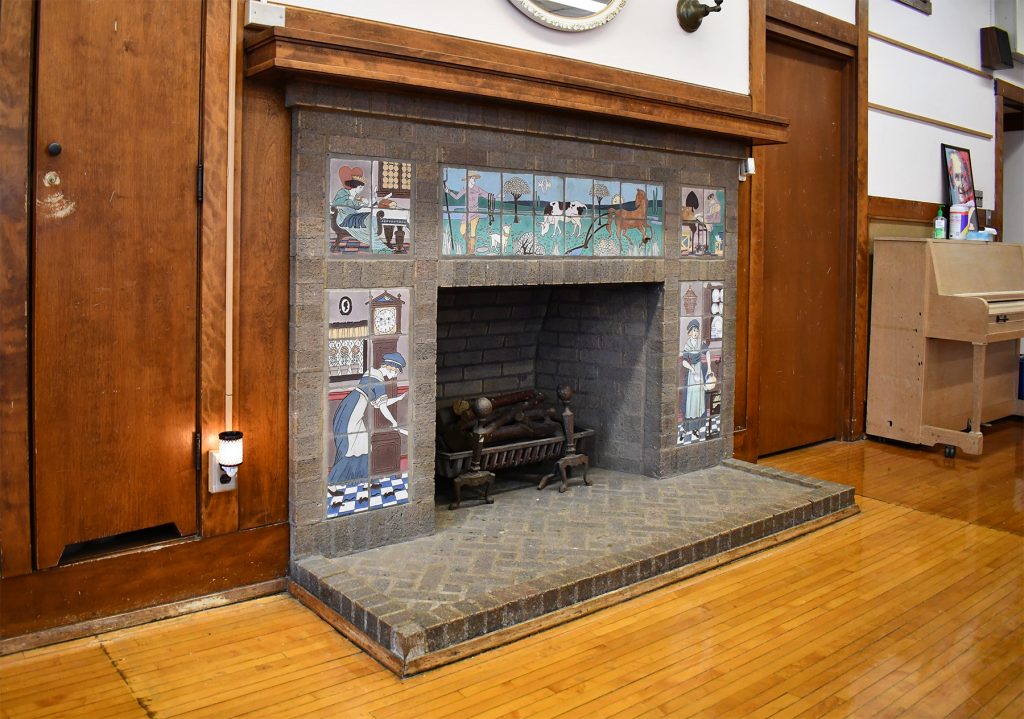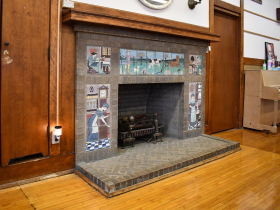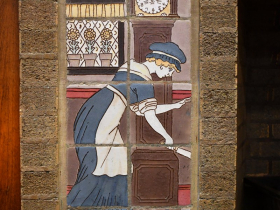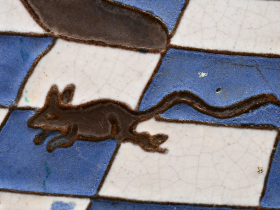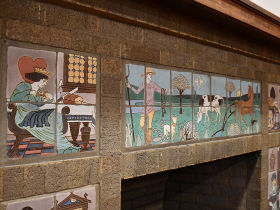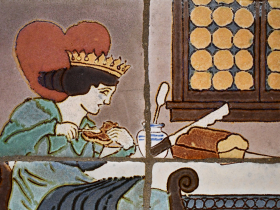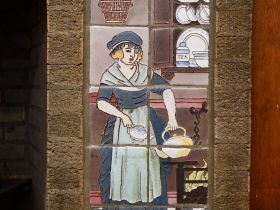Century-Old Illustrated Fireplace Delights Students
First in a series. An inside tour of unique Arts & Crafts tile creations in Milwaukee.
Once upon a time, some public schools in Milwaukee featured fireplaces, often decorated to capture the imagination of young students. A scared child entering kindergarten class for the first time might be comforted and delighted by images from Mother Goose’s nursery rhymes, of smiling flowers, a queen eating bread or a farmer trying to catch his horse.
There are a number of schools in the Milwaukee Public Schools system that feature these tiled fireplaces with delightful imagery, including Keefe Elementary, Hartford University School, Wisconsin Ave School, the MPS Success Center (formerly Green Bay Ave School) and James Whitcomb Riley School, today known as the Riley Dual Language Montessori School. These, according to my ongoing research, were the first schools in the state to feature fireplaces with tiles. There are many period buildings in the metro area — schools, churches, businesses, and private homes — showcasing beautiful Arts & Craft tiles.
The architects, Van Ryn & DeGelleke were hired by the school board in 1912 and designed schoolhouses for MPS until 1924. The specifications for the school’s construction stipulated that the kindergarten room’s fireplace must use tiles of nursery rhymes. The James Whitcomb Riley School, at 2424 South Fourth Street, built in 1921, was one of those schools. Its fireplace showcases five nursery rhymes: Three Blind Mice, Hickory Dickory Dock, Sing a Song for Sixpence, The Farmer in the Dell, and Polly Put the Kettle On.
I had a chance to visit and chat with a group of Riley students about the fireplace in their school. At first they did not recognize the specific nursery rhymes on the tiles. However, when I asked, they started singing other nursery rhymes such as Humpty Dumpty, Twinkle Little Star, The Muffin Man, Ol’ McDonald, Patty Cake, and How Much I Love You. Mia Gaskell, seven-years old, shared that her mother reads these stories to her at night and from a “plushy that plays music.” Ten-year-old Eliana Peña added “we know these from Cocomelon [on YouTube] too.”
Brandon Robins, 8, initially thought the tiles were “painted stone.” Raquel Martín, 9, placed her fingertips on the tiles and said, “If you come and feel it, it’s different.” The students were amazed to learn it was the same material they used to make pottery: clay.
After the tiles were heated in a kiln, possibly as high as 2300 degrees Fahrenheit, the tiles became as hard as stone. The textures have a matte, crystalline finish that make them easy on the eyes.
These designs do not appear in any tile manufacturer catalog, so it is most likely they were custom pieces of art commissioned for the school. What we do know, however, is that the unknown tile designer left us with many intricate details in each picture based on illustrations by English artist and book illustrator, Walter Crane (1845-1915).
In the panels Sing a Song for Sixpence, the tile makers reproduced illustrations from Crane’s The Baby’s Opera: A Book of Old Rhymes with New Dresses, originally published in 1877. The reproductions in tile show much more detail, bringing Crane’s sketches to life. In the tile, the queen has already bitten into a slice of bread held between her delicately-rendered fingers. As for the king in the counting house, the coins are individually outlined and the king, dressed in his robe decorated in spades, is ready to count each one of them. You also see scrolls of his countings and chests with padlocks to keep them secure.
In the tiles for Polly Put The Kettle On, the tile reproduction of Crane’s illustration also comes from The Baby’s Bouquet. The dishes in the cupboard, the hook over the fire, and the outfit Sukey wears resembles the original drawing nearly-spot on. Though, what was originally a print with red, yellow, and black lines has become a tiled design full of color and texture. The floor has blue-and-white checkers that match Sukey’s blue dress and the cobalt decorations on the porcelain dishes, and her blonde hair matches the yellow teapot and flames of the fire.
In the Three Blind Mice, the farmer’s wife is seen with her knife, bending down to cut the mice’s tails. The panel is also combined with the subtle reference to Hickory Dickory Dock, showing Crane’s illustration of the unique clock from The Baby’s Opera. As Raquel Martín notices, there is “a moon and a clock with the face of a cat… meow!”
Today, the school’s original kindergarten room is known as a Community Room, and is used as a shared space for class activities, recess, a Community Learning Center, and special occasions such as the Christmas gift exchange.
Eliana Peña notes how the fireplace is peaceful and calm, adding that “it lets people have fun because it gives people good vibes and doesn’t let people feel down.”
The students also thought about creating new tiles to add above the mantel. Mia Gaskall would like to show “an artist who is drawing a picture of a sunset, which I’m really good at.” And Brandon Robins said he would create “a room full of kids playing with each other and sharing.”
As unique and amazing as the tiles are, the fireplace at Riley school is not the only well-preserved gem in Milwaukee Public Schools. More to come in future stories.
Ben Tyjeski, an art teacher at MPS Garland School, is a tile maker and historian who has written a book on Milwaukee’s Arts and Crafts tile creations. This is the first article in a series, Tile Town, about the tiles.
Photos
If you think stories like this are important, become a member of Urban Milwaukee and help support real, independent journalism. Plus you get some cool added benefits.
Tile Town
-
Washington High School’s Tiled Bubblers Are Unique
 Apr 23rd, 2024 by Ben Tyjeski
Apr 23rd, 2024 by Ben Tyjeski
-
Uncovering The Oriental Theatre’s Mysterious Tiles
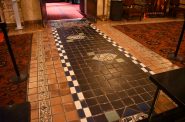 Nov 17th, 2023 by Ben Tyjeski
Nov 17th, 2023 by Ben Tyjeski
-
Nursery Rhyme Fireplace in a “Kindergarten Suite”
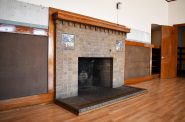 Oct 27th, 2023 by Ben Tyjeski
Oct 27th, 2023 by Ben Tyjeski


